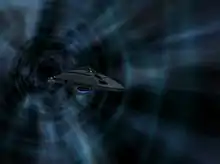Slipstream (science fiction)
"Slipstream" is a science fiction term for a fictional method of faster-than-light space travel, similar to hyperspace travel, warp drive, or "transfer points" from David Brin's Uplift series.
| Spatial anomalies in fiction |
|---|
|
Black holes in fiction • Portable hole • Teleportation in fiction • Wormholes in fiction • Stargate • Warp drive • Hyperspace • Slipstream • Time travel in fiction |
|
|
Usage in Star Trek

Quantum slipstream was a starship drive used in two episodes of the science fiction television series Star Trek: Voyager. It first appeared in the season 4 finale, "Hope and Fear". Similar to the Borg transwarp conduits, the slipstream is a narrowly focused, directed field that is initiated by manipulating the fabric of the space-time continuum at the quantum level using the starship's navigational deflector array. This creates a subspace tunnel, which is projected ahead of the vessel. Once a ship has entered this tunnel, the forces inside propel it at incredible speed. To maintain the slipstream, a ship has to constantly modify the quantum field with its deflector dish; however, the calculations involved are too complicated, and the time available too short for 24th-century Starfleet computer technology. When this technology was discovered by the crew of the lost and stranded USS Voyager, it was hoped this could be used to allow the starship to travel at even greater speeds.
However, in the episode "Timeless", the technology proved to be dangerously unstable, resulting in the loss of all hands of the Voyager in an alternate timeline. Due to a phase variance, the slipstream tunnel, produced by a replica slipstream drive of the Voyager, collapsed during the flight and the ship crashed on a planet near the border on the edge of the Delta Quadrant. Harry Kim and Chakotay survived, because they used the Delta Flyer, which flew ahead of the Voyager, and reached the Earth safely. Some years after this event, they used a temporal communication device to change the timeline and rescue the ship and crew.[1]
Quantum slipstream technology was one of the items requested in the "Think Tank" episode, despite Captain Janeway's admission that they never got it to work properly.
Usage in Andromeda
Slipstream travel is also used in the science fiction television series Andromeda.
Slipstream: it's not the best way to travel faster than light, it's just the only way.
— Dylan Hunt, Episode 1x06: "Angel Dark, Demon Bright"
Function
Slipstream is a series of "strings" connected between planetary systems by gravity. A gravity field generator drastically reduces the mass of the ship and then a slipstream drive opens a slippoint which the ship enters. The pilot then navigates the series of slipstream "tunnels" until they exit via the desired slip point. Usually one has to enter and exit slipstream several times before reaching their final destination. An A.I. attempting slipstream travel has a 50% chance of selecting the correct route at each intersection encountered. Owing to organic "intuition", a living pilot has a 99.97% chance of guessing the correct route to take.[3]
While travellers approaching light speed will encounter time dilation, slipstream travel does not.[4]
Limits of slipstream
Due to the complex nature of slipstream probability and difficulty in mapping slipstream, only biological entities are capable of successfully navigating it. Exiting slipstream near the edge of a galaxy or in certain regions of space could be dangerous because it is difficult to find a slippoint in these areas. If a slippoint cannot be found, or a slipstream drive is damaged, the ship is stranded and limited to slower than light speed.
Usage in Doctor Who
In the episode "World War Three" the Slitheen family from Raxacoricofallapatorius uses a slipstream drive as a form of travel.
Usage in Halo
In the Microsoft video game series Halo, based in the 26th century, slipspace (also known as slipstream space) is the general method of faster-than-light travel. Both the alliance of alien races known as the Covenant, and their human opponents, the United Nations Space Command forces, use slipspace to travel between systems. The mechanics are described in more detail in the novel Halo: Ghosts of Onyx, on page 53.
"Shaw-Fujikawa engines allowed UNSC ships to leave normal space and plow through a dimensional subdomain colloquially known as "Slipstream space." ... The drive used particle accelerators to rip apart normal space-time by generating micro black holes. Those holes evaporated via Hawking radiation in a nanosecond. The real quantum mechanical "magic" of the drive was how it manipulated those holes in space-time, squeezing a hundred-thousand-ton cruiser into Slipspace."
References
- Dwilson, Stephanie Dube (2017-10-09). "'Star Trek: Discovery' New Spore Drive vs. Other Faster-Than-Warp Tech". Heavy.com. Retrieved 2019-10-07.
- "5 Faster-Than-Light Travel Methods and Their Plausibility | For Science! | The Escapist". www.escapistmagazine.com. Retrieved 2019-10-07.
- Deep Midnight's Voice (2003)
- The Lone and Level Sands (2002)